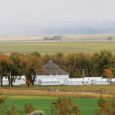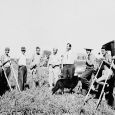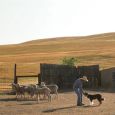The Gift of South Dakota
Subscriptions to South Dakota Magazine make great gifts!
Subscribe today — 1 year (6 issues) is just $29!
Trees and Us
Sep 7, 2011
I once accidentally set fire to a tree stump in our yard. It had been cut, and dry, jagged spires of wood rose where the tree snapped as it fell. Naturally it became the perfect place for a boy to stuff firecrackers.
For the 10-year-old me, the remains of that tree were nothing more than an opportunity for Fourth of July fun. The older and wiser me knows there must have been a story behind that tree. It was part of a line of trees planted along our lot line. Maybe one of the town founders planted it?
It’s interesting how in South Dakota, we form connections to trees. Perhaps it's because when our ancestors first arrived in Dakota 150 years ago they encountered a landscape largely devoid of trees. When we look at the tall cottonwoods around our farmyards and small towns, they are a tangible connection to the pioneers we never knew. They are also full of history.
We’ve written a lot about important trees. There’s the landmark cottonwood that wouldn’t die in Henry. Planted in 1882, it survived a 1971 tornado, a windstorm in 1984 and a fire that destroyed the town café and bar. Victims of this year’s historic Missouri River flood are dealing with damaged homes and other possessions. But Curt Mortenson told us about a 200-year-old cottonwood near his house that’s been surrounded by water all summer. He said a photo taken in the 1880s shows a steamboat tied to it. No one knows the toll the flood will take on trees in the river valley.
In our September/October 2007 issue, Melvin Marousek wrote about a grove of trees his father planted in Meade County. “For more years than I like to remember, I have made periodic pilgrimages to this lonely but, to me, hallowed homestead where so many memories lie waiting to be resurrected,” he wrote. “It is here that lost memories well into conscious thought and long sleeping ghosts drift by – ghosts of many descriptions, some light and airy and cheerful, others sad, tired and grim.”
I heard about another important family tree just today. A stately cedar stood on the John Hynes homestead west of Conde for 112 years until a wicked thunderstorm ravaged the top third of it in the spring of 1994. The loss prompted Earl Grandpre, owner of the Hynes farmstead, to pen a tribute recalling memories and tracing the tree’s grand history.
Hynes brought his son to Dakota Territory to find a homestead in 1882. They filed on a quarter of land a half mile west of Conde. That fall they returned to St. Paul, where the rest of the family had stayed. Hynes told his wife there were no trees on the homestead he had selected. So the next spring, before they all came to Dakota for good, she went to the banks of the Mississippi River and collected a small cedar sapling. She placed it in a suitcase full of dirt from the riverbank and tended to it during the long covered wagon ride west. They planted the tree just southwest of their original shanty.
“Jack and Ed Hynes told me many times the story of this tree,” Grandpre wrote. “They seemed to want to impress on me the importance that they placed on it. They knew that my wife and I would own and farm this land, and though they didn’t say so, I know they did not want me to destroy this tree. They did not have to worry. My wife would never have let me or anyone else hurt this tree.”
That’s because trees can be as important to us as they were to the men and women who brought them here.











Comments